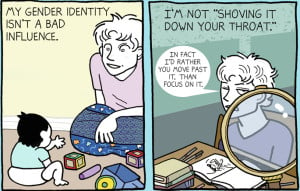There’s been a lot of conversation in the last year about equal pay and the gender wage gap.
Congress has considered, failed to pass, and considered and failed to pass the Paycheck Fairness Act over and over again.
President Obama, to do his own part in tackling the problem, has signed two executive orders with the goal of ensuring equal pay for all federal contractors, regardless of assigned sex.
In fact, the first thing President Obama ever signed into law was the Lily Ledbetter Fair Pay Act, which gave women who have suffered wage discrimination more time to report than they had previously, making it easier for them to recoup their losses.
And for the first time since about 2004, the wage gap budged in 2013, from 77% to 78. That’s right, y’all. We made a cent!
Equal pay isn’t a new issue.
Women have been organizing around it for centuries, and politicians have been addressing it since 1963, when JFK signed the Equal Pay Act into law. Back then, the wage gap was even worse – women earned only 59 cents for every man’s dollar.
It’s been over 50 years since women were guaranteed an end to wage discrimination. Yet, since then, we’ve come less than halfway to closing the gap.
Despite a plethora of statistics, experiences, and investigations that have uncovered gender-based wage discrimination, the wage gap persists. And one major reason why is that some folks refuse to believe it exists.
You read that right: Some people simply refuse to believe that it exists.
And their central debate point?
Trying to prove that the oft-quoted 77 cents (now 78) that a woman makes for every man’s dollar isn’t valid.
But let’s dispel that argument right now.
Because a deeper look at the math shows that it is.
But Wait—Where Does the 78% Statistic Even Come From?
Good question.
There’s a ton of data out there about the wage gap – and I won’t ask you to wade through it yourself.
But the most reliable data comes from the government bureaus tasked with keeping tabs on income, poverty, and economic growth in the United States: the US Census, the Bureau of Labor Statistics, and other research by the Department of Labor.
It makes sense to trust data collected by these agencies, not only because it’s as impartial as possible and often coming from the largest possible sample, but because it’s possible to chart its growth and change over time.
These data sets show us how the wage gap has shrunk in the last 50 years, and they illustrate how Americans overall have fared economically along demographic lines like race, age, region and geographic location, and sex – in some cases, for close to a century.
The Census Bureau’s Current Population Survey and American Community Survey for 2013 revealed that women of all races earned 78.3% of what men of all races earned. Those studies also highlighted the wage gap for men of color, and how women of color fare in contrast to their male counterparts.
Across the board, women earn less than all men. But when you break it down by race, you can see that some men are suffering, too:
Latina women make only 54% of what white men make, and 90% of what Latino men make.
American Indian and Alaska Native women earn 59% of what white men earn and 85% of what American Indian and Alaska Native men earn.
African-American women earn 91% of what Black men earn, but only 64% of what white men earn.
Asian-American women earn only 79% of what Asian-American men make, but 90% of what white men earn.
This data is culled from the median annual earnings of full-time, year-round workers 15 and up, The 2013 CPS had over 140,000 respondents in this category, all of whom were pretty much evenly split along lines of sex.
Other studies have been completed examining the earnings gap between men and women based on hourly and weekly wages, too, and have echoed the same results. (The BLS, for example, found in 2012 that full-time women were paid 76.5% of what full-time men were paid each week.)
It’s true that the government agencies collecting data on employment and income don’t collect information that shows us the specifics of these people’s lives.
After all, this data is quantitative, not qualitative.
There are no explanations from men or women about their earnings; we don’t know who left work to be a full- or part-time parent or who was working overtime to make ends meet.
But how the wage gap is calculated does a lot to minimize the impact of those factors nonetheless.
The math behind that 78% figure matters just as much as the figure itself.
The wage gap is measured by stacking up the median income of full-time, year-round workers who are women next to the median income of men in the same category. Both of these factors are pivotal, because they make the data a lot more solid.
We Compare Full-Time Workers to Make Men and Women’s Experiences More Directly Comparable
Full-time, year-round workers are the most comparable when examining wage difference – because they’re expected to work the same hours and during the same time period.
Hourly and part-time workers might be seasonal or have more flexibility to design their own schedules (or be assigned them at random), making their experiences less identical.
Using full-time, year-round workers for the sake of pinpointing the wage gap makes it a little easier to conclude that differences between men’s earnings and women’s earnings aren’t about how many shifts they picked up or whether they didn’t work for three months out of the year.
This isn’t to suggest that the wage gap doesn’t still exist for part-time or hourly workers, or that it’s never been calculated. In fact, when you add up the median of all male workers’ earnings to against women’s, including part-time workers, there’s still a gap – of slightly less than 30% according to the Census data from 2013.
And We Calculate Using the Median to Prevent Anyone’s Extreme Income from Skewing the Results
Using the median earnings of these workers also helps safeguard against skewed data on the wage gap (although one can still be found between the mean earnings of men and women). That’s because the median of a data set like this one can be more representative of the real, lived experiences of the respondents overall than the mean.
The median is found by lining up numbers in order of least to greatest value and then picking the one that’s smack-dab in the middle.
When we talk about what the “average” American woman is losing out to the wage gap, we’re talking about the woman smack-dab in the middle of her Census-taking counterparts. She’s not the richest one, and she’s not the poorest one. She’s just sort of average.
Most of the time, when we talk about “averages,” we’re talking about the mean of a set of numbers. The mean is found by adding up a bunch of numbers from a pool of data and then dividing it by the total amount of numbers.
But both median and mean can be used to define an “average” experience with a data set like that of the Census. The only difference is that using median makes it a little harder for extreme wealth or extreme poverty to skew the income results for each sex’s data set.
If we interviewed 100 people, asked each for their annual earnings, then ordered them from least to greatest in value and picked the number in the middle, we’d have a median.
But if we interviewed 100 people, asked each for their annual earnings, then divided the sum of those earnings by 100, we’d have the mean.
And if one person in that group made a couple million more dollars than everyone else per year, the mean of that data set might not accurately reflect the experiences of the entire group. If everyone else interviewed made $30,000 on the dot, that one person making $3,000,000 per year would skew the mean for the group by almost $30,000.
The median, however, would have been $30,000. And in a pool where 99% of the research participants make that, it gives us a more accurate image of the majority experience of the group.
Measuring the wage gap using median income for men and women leaves us with a pretty good picture of John and Jane Doe in America.
In this case, I think it’s even helpful to think of the median not only as the middle-of-the-line income bracket for men and women, but as a glimpse into what the “average” man or woman has the opportunity to earn.
If men were all making more because they work harder, smarter, and better than women, they wouldn’t be working in low-wage fields with women, whom they outearn even in the lowest-paying occupations.
If women were all taking lots of time off from work to raise their kids, they wouldn’t be forging new paths in male-dominated sectors like math, science, and business – where they continue to earn less than their male counterparts.
Some men are working middle-of-the-road jobs, just like some women are. And when we measure via the median, the high-powered CEOs don’t take away from the data representing what they earn.
The men and women in the middle give us a picture of where a woman and man with similar places in the world are in terms of earnings. And that picture is lopsided.
According to the overall results of the 2013 Current Population Survey, the average income in America was $28,829 per person that year. But the median men’s income overall was much higher (at $40,298), whereas women actually made less than the national average in contrast, clocking in at $28,402.
Considering there were similar amounts of men and women surveyed, that boggles my mind a little bit.
Narratives about equal pay and the wage gap frame income as a matter of women earning less than men – and they do. But it’s also worth noting that when you think of Americans overall and pool their incomes, it seems like a lot of men are also just earning more than a lot of us, regardless of sex.
A huge source of that disparity could be that women get stuck working in sex-segregated occupations like nursing, teaching, and administration – most of which are undervalued and low-paying, but still pay men more than women.
Another could be that women are pushed out of some of the most lucrative fields, as well as on-the-job discrimination that keeps them from moving up in their career.
There’s data to support the idea that women aren’t so much “making bad choices” that lead to their relative lack in wealth, as being held back at work and pushed into lower-paying career tracks in their respective fields.
That’s because it isn’t men’s exorbitant wealth, nor their “loftier ambitions,” keeping the wage gap high. It’s persistent sex discrimination and segregation in the workplace.
So What Does the 78% Really Mean?
There’s a lot of data in the world about the wage gap and to what extent it’s impacting women’s earnings.
Some gaps found are smaller, and some bigger, than the 22% difference between men and women’s media income we’re talking about when we cite the 78% statistic from the Census.
There is no one number that will represent every woman and man’s experience with the wage gap.
Some men will be underpaid by their employers because of their race or sexual orientation. Some women will be paid the same as their male counterparts, or move up the ladder and ultimately earn more.
What that 78% number shows us is how American women overall are faring. We don’t need more proof that the wage gap exists, because we know it does.
We know that it begins as soon as men and women enter the workforce.
We know that women earn less in male-dominated fields and feminized fields. In fact, we know they earn less in pretty much every job.
No matter what factors are accounted for, the wage gap persists.
Study after study has been unable to find a 0% wage gap, even when researchers account for various factors and remove a good chunk of the difference. AAUW, when adjusting for factors like major, occupation, economic sector, hours worked, GPA, age, and marital status, still couldn’t explain away 7%.
That’s because the 78% figure isn’t necessarily a literal statement about women’s lives.
If a man and woman working the same job at a company examined their paychecks, there likely would not be an exact 78.3% difference. (If there is, report that, y’all!)
But what the 78% indicates is how much work is left to ensure that women and men have the same opportunities at work.
There’s a 23% gap in what women in the middle earn compared to men. There’s a 23% gap in how much people in the middle of the line can make, based on their sex. And there’s a 23% difference in what’s possible for women versus what’s possible for men.
Some folks have claimed that feminists and legislators alike use the 78% figure because it’s the largest, most shocking figure. But that isn’t true – and that isn’t why this figure matters so much.
It matters because it’s part of a larger historical context of our inequality, because the fact that it’s closing and narrowing proves that feminism has played a role in shrinking women’s economic equality. It matters because it’s broad-reaching and all-encompassing.
It matters because it’s proof that we haven’t done enough.
Across lines of age, race, ethnicity, location, career choices, familial obligations, industries, and educational attainment, women make less than men. And altogether, women are stuck making 78% of what their male counterparts have the potential to earn.
And it’s about time we focused on fixing that fact rather than trying to pretend it isn’t true in the first place.
[do_widget id=’text-101′]
Carmen Rios is a Contributing Writer for Everyday Feminism. She splits her time disparately between feminist rabble-rousing, writing, public speaking, and flower-picking. A professional feminist by day and overemotional writer by night, Carmen is currently Communications Coordinator at the Feminist Majority Foundation and the Feminism and Community Editor at Autostraddle. You can follow her on Twitter @carmenriosss and Tumblr to learn more about her feelings.
Search our 3000+ articles!
Read our articles about:
Our online racial justice training
Used by hundreds of universities, non-profits, and businesses.
Click to learn more





















